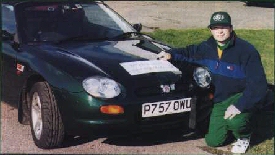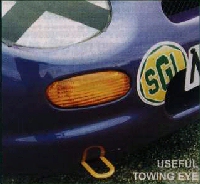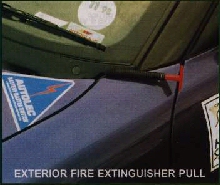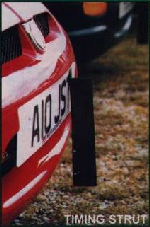Race your MGF
by Graeme Bishko
3-2-1- GO
If you've ever wondered how you can get to drive competitively at some of
the great motor racing venues around Britain, here is your answer - sprints
and hill climbs. For a comparatively small outlay you can drive as fast as
you like around some great tracks and up famous hills. You don't need a
particularly fancy car and if you own an M.G. you have easy access to
well-organised and fun Championships.
This article aims to de-mystify what you need to do in order to compete.
I would strongly recommend that you first attend a couple of events as a
spectator or even a marshal. Marshals get to stand near the track and watch
up to 400 attempts at a given corner - a great way to learn the quick lines!
This will give you a much better idea of the sort of things you need and
what you will be asked to do. Nothing beats seeing the action and talking
to the drivers.
I will explain here the step by step guide as to what you need and give some
pointers as to where to get it.
Firstly, a sprint is a timed run around a track. Only one car starts at a
time (though there may be two cars on different parts of the circuit at once).
You compete only against the clock. Competitors are grouped together in classes
and there are prizes for winners of each class depending on the number of
entrants. A hill climb is basically the same but takes place on a (usually)
narrower track and up a hill.
Pre Season - what you need.
License
The first thing you need is an RAC Motor Sport Association (MSA) license.
These come in a wide variety of forms, from rank amateur (you) to international
super star. Your licence will cost £27.00 and you need a minimum of
a "Non-race Class B" license which is the lowest grade you can get (and therefore
the cheapest). You don't need to worry about doctor's declarations or any
training, just fill in the forms and they'll send it to you in the post.
You can contact the MSA on 01753 681736.
With your license you will receive a thick rule book (called the "Blue Book")
and four issues of the MSA’s own motor sport magazine. The Blue Book
lays down every rule associated with all forms of motor sport but thankfully
you won't have to comply with very much of it! I'll highlight here what you
do need to take note of but it is worth reading through as much of the relevant
stuff as you can.
One word of warning however: MSA licenses run from January 1st till the end
of the year. If you apply in August you will pay the full amount but you
will have to renew in January. That caught me out in my first year!
Joining a championship
You will need to join a Championship in order to get information about what
events are coming up and how to enter them. For M.G. drivers the obvious
choice is the Moss International Speed Championship. This is split into a
Northern and Southern series. MGF drivers have another choice - the MGF Abingdon
Trophy which is for standard road-going cars. This was run for the first
time in 1998 and included both races and speed events. Most novice competitors
chose to enter the speed events only, because of the expense involved in
racing.
The Moss Championship details can be acquired from Sue Garvey (01782 522902)
while the MGF Abingdon Trophy is run by Peter Browning from within the M.G.
Car Club.
The Championship organisers keep you informed as to your Championship position,
results from events and send you the regulations for each forthcoming event.
Once you receive the regs, it is best to send these off as soon as possible
as many events are heavily over subscribed. Each event will cost you about
£60. A quick plug for the Silverstone Sprint at the M.G.C.C. Silverstone
International in June where the entry fee last year was £60 but that
included two full adult entry tickets to the whole event (worth £30)
and a competitors mug!
Personal Safety Equipment
There are two pieces of personal safety equipment that you must have: a crash
helmet and a flame proof suit. As usual, there are differing levels of equipment
and the level necessary for this grade of motor sport is the lowest. The
flame proof suit can be single layer Nomex, Proban or similar (full race
suits must be triple layered). Helmets must conform to certain British Standards
and should display the correct sticker and should fit properly.
Although you can get a satisfactory race suit for around £70, they don't
look as nice as the ones the F1 guys wear! Nicer suits are available and
if you have aspirations to race, you will want a triple layer suit for that.
Fire proof boots and gloves, while not obligatory, are also recommended and
a balaclava is another option.
If you are running an open car, you will need a helmet with a visor or goggles.
If you are buying an open face helmet check whether an approved visor can
be fitted as an accessory. I bought an open face Sparco Pro Jet helmet and
now I must run with the roof of my MGF up because there is no approved visor
for my helmet. I could wear goggles but that's a little uncomfortable with
my glasses!
What your car needs
Timing strut
For most speed events, timing is performed by a light beam system. To standardise
how cars cut the beam, the Blue Book lays down rules for a timing strut to
be fitted to each car. This is basically just a rectangular bit of metal
(or card) that affixes temporarily to the front of the car. You can work
out all sorts of complicated methods to secure it, but often double sided
tape is sufficient. I'm able to use one of the screws that hold my number
plate.
The specific requirements for the strut state that it must be "matt black
over its total area (254mm x 51mm). The bottom of the strut shall be not
more than 200mm from the ground and the top not less than 454mm from the
ground." (MSA Rule L 10.12.1)
Fire extinguisher
This is listed as optional in the Blue Book (Rule L 10.11.3) but the M.G.C.C.
Moss and Abingdon Trophy rules specify that you must have it. You need at
least a 1.5kg fire extinguisher firmly secured to the car. These cost around
£45 and you may have to get a 1.75kg model. It is easy to screw this
to the floor somewhere in the passenger compartment and it can be left in
for normal road use. I have mine just in front of the passenger seat in my
MGF.
Race numbers
Just before each event you enter, you will be sent details of your entry
number. This number must be displayed on your car. The MSA rules stipulate
a black number on a white background, but for the purposes of speed events,
contrasting numbers (say à àwhite numbers on a red car) are
fine.
You can either make numbers up with masking tape (curved numbers are tricky),
buy pre-cut numbers, or make up sets from magnetic plastic. Abingdon Trophy
cars are given magnetic number panels. |
 |
Scrutineering points
These are a few things that scrutineers may look for.
Yellow tape around the battery ground lead, supposedly so that it can be
cut quickly in an emergency by marshals.
Ignition off switch marked. This is really a rule for the specialist cars
which start and stop engines by elusive buttons on the dashboard. A sticker
somewhere near your key on the steering column with an arrow pointing in
the "off" direction should be sufficient.
As none of these things are hard to fix on site, it is sometimes best to
just listen to what the particular scrutineer wants, and then comply. If
you don't have the right sort of tape or tool, there is a very good chance
that someone in the paddock will help you out!
If you are planning to compete with a road car you will usually be eligible
for an unmodified class. Each particular class has various restrictions on
what you can and can't do to the car in the way of modifications. These are
generally set so that if you don't want to modify your car, you won't be
at a disadvantage against people with more time and money to spend on tuning.
The most basic thing you can usually do is to change the air filter but more
expensive suspension or engine modifications are usually prohibited in the
unmodified classes.
You will need an MOT certificate if the car requires one but if you are planning
to drive to events in your competition car, this should go without saying!
At present the RAC is the only motoring organisation that offers recovery
from an off road site. You need to mention that you are in the MSA when you
join and you will get a discount of 15% off the membership and you will be
covered specifically should you have an accident in an event and need a tow
home. No other motoring organisation does this: both the AA and Green Flag
specifically exclude motor sport accidents in their policies.
Car Wear and Tear
Tyres - If you are running on road legal tyres they should be fine for events.
The Blue Book has a list of permitted tyres but you are unlikely to have
anything so exotic on your car that you can't use them at an event. I've
not found tyre wear to be excessive. I've competed in quite a few autotests,
sprints, hillclimbs and even 15 high speed laps of Castle Combe in my MGF
and I still have tread on my front tyres after 25,000 miles.
Other Mechanicals - Obviously the clutch and transmission are going to take
a bit more pounding than in usual driving but you should remember that each
event usually consists of up to 5 runs each lasting around 60 seconds or
less. How many times last week did you give it a bit of stick away from the
lights?
Extras - What you don't need but might like!
Tyres - There seems to be a lot of black magic associated with tyres. Sprint
paddocks are full of people checking pressures, pumping up and letting down.
I've not worked it all out but one day when I'm consistent enough at driving
the same line, I may be able to make a judgement! You should have an accurate
tyre pressure gauge (about £45 with range 0-40 lbs.) and a pump. I
originally had an electric pump (I know very lazy) but they're actually a
bit of a pain and a good foot pump is both cheaper and quicker.
It is not necessary to change your tyres to compete. If you are coming up
to needing a new set of tyres, however, it might be worth asking around to
see what others recommend for your car. You might be able to get a tyre with
more grip (but a shorter life) than you would normally fit.
Stickers and signs
Many sign writers will make up vinyl signs that can either be stuck directly
onto your car or put on magnetic backing. These aren't very expensive and
you might like to put your name (or your car's name!) on your car when you're
competing. You might also see if you can come to an informal sponsors hip
deal with a friendly company and swap car space for your entry fee perhaps.
Step by step guide to race day
You are already signed up in one of the Championships so notification of
an event was sent to you early. You read the regulations, filled in your
form and sent off your cheque. About a week before the event you received
confirmation of your entry and were assigned a competition number. You were
also told what order the competition would run in and what time it starts.
Events are widely scattered and usually you are told of the nearest big town.
Most organisers help you by providing a map or putting up signs to direct
you to the event. You should get there with plenty of time of course!
The event regulations should have contained instructions as to where to park.
Some venues allocate numbered spaces for each competitor corresponding to
their competition number, others allocate certain areas for each class while
some just tell you which field to park in. Try to follow the rules and if
in doubt, ask.
Signing on
Usually the first thing to do when you've arrived and parked is to go and
sign on. For this you will need: Race license, Club membership card and anything
else the regulations specifically ask for
Walking the Course
If allowed (it is at all hill climbs) you should definitely walk the course.
There is usually a set time by which the course must be cleared so if you
are running a little late you might want to skip signing on until after you've
walked the course. If you've never been to a venue before, walking the course
should help you avoid any really silly mistakes on the first practice. It
should also enable you to push just a little bit from the very first run.
I won't pretend that it is easy to judge braking zones or traction when you
are on foot, but I'm told that if you do it often enough, you get a good
feel for these things.
The other reason for walking (and the reason why all the most experienced
competitors do it no matter how many times they've been to a particular venue)
is that you can find out the track conditions for the day.
Scrutineering
Before you can be scrutineered, you will need to spend some time putting
on your timing strut. Race numbers should also be applied and any other signage
you are running with should be in place.
Before you have your car scrutineered, you may have to remove unnecessary
items from the boot and passenger compartment. You won't need your mobile
phone on the run! Many competitors also remove their spare wheel and jack
for weight saving reasons. You can usually find a small pile of bric-a-brac
behind each car in the paddock. A small tarpaulin or ground sheet to cover
your stuff might also be a good investment.
Scrutineering is the check that must be performed on your car before it is
declared fit to run. At your first event your helmet may have to have an
MSA sticker applied to it which will be checked at subsequent events. Your
overalls will be inspected as well. Then your car will be checked: timing
strut, fire extinguisher, numbers, throttle linkage, tyres, wheel nuts and
brakes. This is all done visually and if your car is road legal you shouldn't
have much to worry about. Some venues will check noise levels, but again
most MOT worthy cars shouldn't have any trouble. When the scrutineer is satisfied
he will give you a sticker or card which will be checked at the start of
your run.
 |
 |
Convoy run
If the event is a sprint at a race circuit there may be a convoy lap in lieu
of a walk round. This will consist of everybody snaking slowly round the
circuit and back along the return road (if there is one). The idea is not
only to get an idea of where the track goes, but also to familiarise yourself
with marshal's posts and other features.
Practice runs
Most events run in class order. Some events are very strict and require all
of the competitors to run strictly in numerical order too. When it is getting
close to your turn you should start your engine and listen out for announcements.
When called you should line up for the start.
At the start line
Once you've got to the front of the queue you will be lined up for the start.
The exact procedure differs from venue to venue so listen to what the marshals
tell you. Sometimes you will be held on the line by marshals or with a wheel
chock. Most of the time marshals will want to roll your car up to the line
by hand to get the positioning right.
There will usually be a red light and when that changes to green a marshal
will tell you to go in your own time. Don't spend too long waiting after
the light goes green but remember that the timing is from the moment when
you move, not when the light changes.
The run
Sorry, but someone more experienced should write this bit! Suffice to say
that if your car is precious and uninsured (your road policy will not cover
this use) then the old maxim: "to finish first, first you have to finish"
should apply. I also like to abide by the "brake early to avoid disappointment"
rule, especially on the first practice run!
Back in the paddock
Once you get back to the paddock you will be interested in your time. This
will be displayed usually near the place where you signed on. It is a very
good idea to look at other times in your class and get a feel for how well
you are doing. Once you've done that you basically have all the time 'till
your next run for socialising and chatting. It's really quite a sociable
sport and there is a very good camaraderie amongst the M.G. drivers who take
part.
At the end of the day
I'm reliably informed that if you do well you can sometimes win a prize!
It is worth checking and not running off home if you have a hope of taking
away something for the mantle piece!
A few days or weeks after the event, the organisers usually send out a complete
list of the results. The time this takes to happen varies widely from event
to event. Some events don't send out results, however, so you may want to
ask the organisers and see if you can take some home at the end of the day.
Final words
If you're new to a track, don't push it too far on the first run. Some of
the hill climbs especially have very little run off area so mistakes can
be costly. If you are nervous you might be best trying an event like Silverstone
as your first where huge run off areas, designed to allow much faster cars
than you to fall off the track without hitting anything, are a very nice
feature!
Finally, remember that the idea is to have FUN and with the Moss Championship
and MGF Abingdon Trophy this is guaranteed! |
 |



